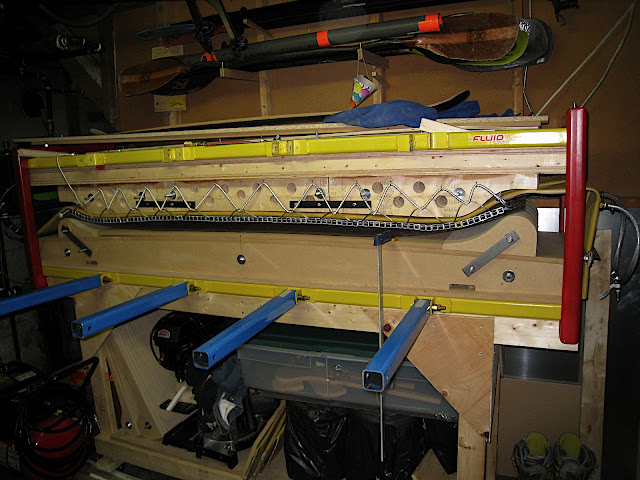Posted: Wed Apr 23, 2014 7:42 am
well, actually the "flat" plywood (or MDF) I'm refering to is cambered...
Just to explain my setup, here's a picture of my press (it has slightly changed since the photo was taken, but the principle remains the same) :
- I have a "camber block" on the bottom, made from MDF ribs, when this picture was took it was covered by a 5/8" MDF sheet.
- On top of this camber block (which is always in the press) I put tip and tail molds + a "flat" piece of MDF (now birch plywood) in between. this "flat piece" confoms to the "camber block" and that's the part I was refering to in my previous post.

This setup only allows me to make skis with some camber underfoot, for now I can't do flat underfoot or even reverse camber skis, but I'm working on it !
As I said, when the picture was taken, I had a MDF sheet covering my whole "camber block".
I noticed after some pairs got pressed that my bases where not perfectly flat, after some investigation I noticed that this layer had some (contrary of bumps ? english wording help please ?) so I basically removed it and resurfaced the whole camber block with a router bridge.
I aslo noticed the flat interchangeable piece of MDF I was using between the tip and tail molds had the same issue.. so I switched to plywood... I have yet to see if that solved my problem on the long run...
I'm pretty sure repeated seasonal humidty changes + pressure and temperature while pressing takes its toll on the MDF molds. I believe that a full-ribs mold (= no "flat" piece of MDF anywhere) will survive longer. but I'm not sure that's why I'm curious about the MDF molds used in the industry.
Just to explain my setup, here's a picture of my press (it has slightly changed since the photo was taken, but the principle remains the same) :
- I have a "camber block" on the bottom, made from MDF ribs, when this picture was took it was covered by a 5/8" MDF sheet.
- On top of this camber block (which is always in the press) I put tip and tail molds + a "flat" piece of MDF (now birch plywood) in between. this "flat piece" confoms to the "camber block" and that's the part I was refering to in my previous post.
This setup only allows me to make skis with some camber underfoot, for now I can't do flat underfoot or even reverse camber skis, but I'm working on it !
As I said, when the picture was taken, I had a MDF sheet covering my whole "camber block".
I noticed after some pairs got pressed that my bases where not perfectly flat, after some investigation I noticed that this layer had some (contrary of bumps ? english wording help please ?) so I basically removed it and resurfaced the whole camber block with a router bridge.
I aslo noticed the flat interchangeable piece of MDF I was using between the tip and tail molds had the same issue.. so I switched to plywood... I have yet to see if that solved my problem on the long run...
I'm pretty sure repeated seasonal humidty changes + pressure and temperature while pressing takes its toll on the MDF molds. I believe that a full-ribs mold (= no "flat" piece of MDF anywhere) will survive longer. but I'm not sure that's why I'm curious about the MDF molds used in the industry.